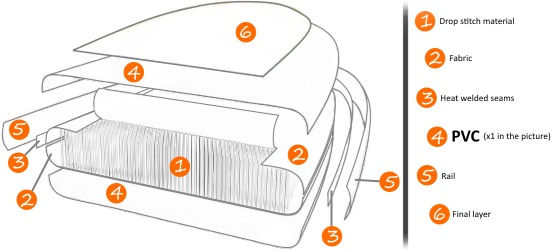What Is PVC? (2021)
Brands usually mention how many layers and/or what quality “PVC” they’ve got in their iSUPs. This piece of content aims to make sense of what they really mean by that. What is PVC, why & how is it being used + extra info.
PVC, short for polymerized vinyl chloride, is a strong and lightweight plastic.
Polymerization is basically a chemical process where molecules (monomers) are connected together to form bigger formations and shapes (polymers). Vinyl chloride, one such monomer involved, is thus polymerized (connected together) to form this lightweight plastic material (polyvinyl chloride, PVC).
The PVC can either be rigid (RPVC) or flexible (rubber-like alternative).
PVC is made softer and more flexible by the addition of plasticizers. If no plasticizers are added, it is known as uPVC (unplasticized polyvinyl chloride) or RPVC (rigid polyvinyl chloride).
Flexible PVC is used in the construction of iSUPs (inflatable stand up paddle boards).
PVC can be regarded as a natural resource saving plastic compared to the other plastics, as it takes less unrenewable materials to make, but it backfires real good with the consequences afterwards (it’s the most toxic one and not renewable due to additives and modifiers used in the mix).

In this illustration, there’s 1 (one) PVC layer. Nowadays, most non-performance iSUPs have 2 or more layers of PVC material so as to last longer and withstand more beating.
Now that you have a picture of what PVC is, you might have more questions.
What makes it strong, is it water resistant, does it melt or react in some way if left under the sun, etc. In other words, what exactly is PVC that’s being used in iSUP construction and how does it concern you? I don’t know about you, but I myself would want to know a little more about those things.
I mean, is the smell of a newly arrived iSUP healthy? IS IT? (it’s not; I mean, which artificial material was anyway?)
With that, I may have sparked your interest and I’m not just writing the following to myself anymore…
Things You Might Want To Know About PVC In iSUPs
Why is it being used in inflatable stand up paddle boards (construction)?
The flexible PVC is used in iSUP construction for its beneficial properties and attributes which make it easy to work with and apply. For example, when heated, PVC doesn’t burn, it liquifies, this makes it easy to mould into the desired shape. It’s poured on the fabric that’s holding drop-stitch together, and then evenly, very carefully and accurately, spread all over. It’s also cheap and readily available when compared to other suitable materials, and has long-lasting attributes.
Why is it being used in inflatable stand up paddle boards (function)?
Generally speaking, PVC is simply an air-tight layer holding it all together. The more layers there are, the more rigid the iSUP becomes. Nowadays though, most of the bigger brands have taken this a few steps further and applied all sorts of additional enforcing materials in the mix.
Sidenote:
A single layer PVC material, as you can imagine, is not ideal, unless the aim was to cut down on costs and make the whole thing super cheap.
How durable is the PVC used in iSUPs?
Depending on how it’s put there, and also, what additives and modifiers are used in a particular soft (flexible) PVC, it can be highly resistant to corrosion caused by weather, checmicals, impact and scratching, and thus is considered to be long-lasting.
But the PVC in the iSUP still needs to be cared for.
With heat resistance additives, the soft PVC used in iSUPs can tolerate higher temperatures. Do NOT burn your iSUP.
With UV radiation resistance additives, the PVC is more resistant to UV rays, but it’s still best not to leave it under the sun when not using the iSUP (without the additive, UV rays are PVC killers).
Salt can dry and absorb into PVC, making the degregation process faster, that’s why it’s advised to wash one’s iSUP with fresh water after salt water paddling.
Is The PVC Used In iSUPs Safe?
Let’s just say I shouldn’t have checked for any potential risks when it comes to the PVC material used in inflatable SUPs…
In general, there aren’t any considerable risks, otherwise it would be banned by now. It’s when you’ve thrown your iSUP away and due to outside elements the toxins start to emit and pollute the environment.
I get mixed feelings from this, but in this article about what PVC is, written in pvc.org it says that (somewhat) pure PVC consists of 57% chlorine and 43% carbon, add in the mix all sorts of other chemicals (additives and modifiers) and you get a PVC with lots of “good” qualities, such as better heat resistance (WITHOUT this, PVC might start to already melt at around 60°C | 140°F to 260°C | 500°F – this would be one of the scenarios where toxins emit) and other anti effects (to keep the toxins from reacting and emitting). Doesn’t mention anything about health risks though, so that’s why I’m getting mixed feelings reading it, as if there were no risks whatsoever and was even the best material in the world…
It may be cheap, but that doesn’t make it “best”, and although toxins aren’t being emitted during use, toxins are involved during manufacturing and once again when it’s at the dumpsite suceptible to elements making the iSUP emit them.
When you happen to look around for more info on this, anybody benefitting from that industry will heavily downplay all the negative aspects and strongly emphasize the positives. It can be a bit alarming once you’ve read too much.
PRO TIP: if you bought a new iSUP and it smelled weird on arrival, just leave it outside (in a safe location) to get some air – leftover chemical fumes from manufacturing (they’ll either depart or dissolve in the air)…
